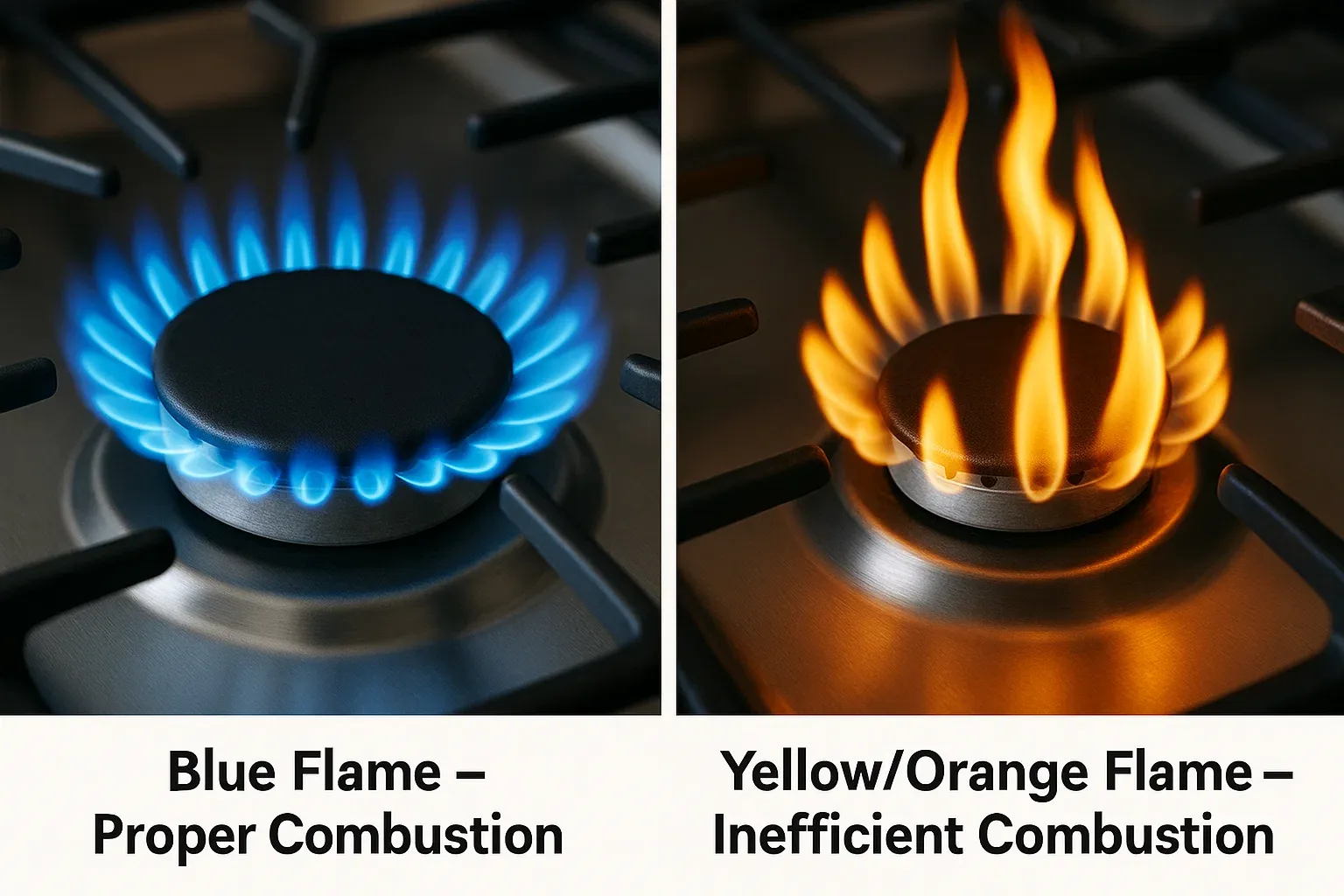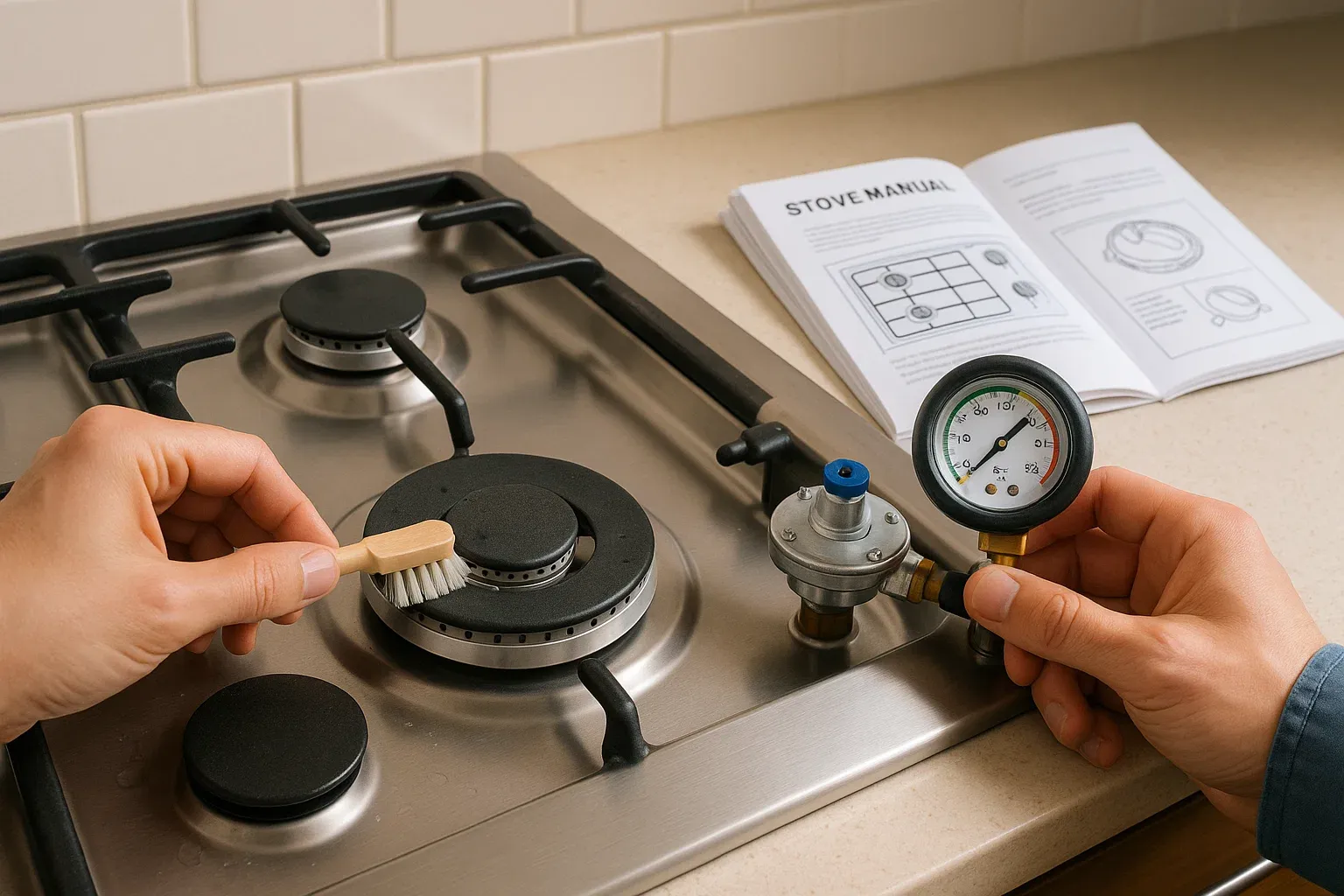Blog

7 Reasons Your Cooktop Burner Flame Is Too High and How to Fix It
Is your cooktop burner flame too high? You're not alone. A high flame on a gas cooktop can cause uneven cooking, energy waste, and safety risks. Identifying the underlying causes of the high flame and addressing them promptly is essential to ensure safe, efficient cooking. This guide covers seven common causes of high burner flames and provides practical steps to resolve the problem.
Key Takeaways 🔑
👉 A typical gas burner flame should be blue, indicating efficient combustion.
👉 High flames may indicate a problem with gas pressure, burner cleanliness, or burner parts alignment.
👉 Safety is critical. If you cannot resolve the issue yourself, seek professional repair services.
👉 Regular maintenance is essential for optimum burner performance.
Understanding Gas Range Flames: The Science Behind It 🎯
To understand why your cooktop burner flame is too high, it's crucial to know how gas burners work. Gas cooktops operate using natural gas or propane. These gases flow through small openings called orifices, mixing with air to create a flame that heats your cookware.
A blue flame indicates proper combustion, which balances the gas and air ratio. However, a yellow or orange flame suggests inefficient combustion, which can lead to problems like high flames, gas waste, and uneven heat distribution.
The Ideal Gas Burner Flame
👉 Blue Flame: Represents proper combustion and evenly distributed heat.
👉 Yellow/Orange Flame: Indicates incomplete combustion, leading to wasted fuel and increased carbon deposits.

7 Reasons Why Your Cooktop Burner Flame Is Too High & How to Fix It 📢
Understanding the specific reasons for high burner flames will help you troubleshoot and resolve the problem more efficiently. Here are the seven common causes of high flame on your gas stove:
1. Dirty or Blocked Burner Ports
Cause: Food particles, grease, or debris can block the burner ports, restricting the gas flow. This causes the flame to increase in height and irregularity.
Solution:
👉 Turn off and cool the burner.
👉 Remove the burner cap.
👉 Inspect the ports for blockages.
👉 Clean the ports using a small brush or toothpick.
👉 Regular cleaning can prevent this issue and ensure efficient gas flow.
2. Improper Burner Cap or Head Alignment
Cause: A crooked burner cap or misaligned burner head can cause uneven gas flow, leading to high or erratic flames.
Solution:
👉 Turn off and cool the burner.
👉 Check the alignment of the burner cap and head.
👉 Refer to the manual for correct installation, or adjust them according to the ideal position.
3. Incorrect Gas Type: Using LP Gas on a Natural Gas Stove
Cause: If you've recently switched to LP (propane) gas on a stove designed for natural gas, the flame may become too high due to incorrect pressure regulator settings.
Solution:
👉 Check the stove installation guide to ensure it's set up for LP gas.
👉 A gas technician can help convert the stove if needed.
4. Burner Flame Needs Adjustment
Cause: The low or simmer setting may be set too high. Incorrect burner flame adjustment could cause unnecessary high flames.
Solution:
👉 Turn off the burner.
👉 Remove the burner knob and adjust the valve screw with a flat-blade screwdriver.
👉 Make minor, gradual adjustments until the flame height is appropriate.
📌 Tip: Adjusting the burner flame can significantly impact cooking efficiency and safety.
5. Incorrect Gas Supply Pressure
Cause: Excessive gas pressure can cause uncontrolled high flames, a common issue with faulty gas regulators.
Solution:
👉 Consult a professional technician to inspect and adjust the gas pressure to the correct level.
👉 Ensure the regulator is in good condition.
6. Faulty Pressure Regulator
Cause: A malfunctioning pressure regulator reduces gas supply pressure. If the regulator is faulty, it can cause high, inconsistent flames.
Solution:
👉 Schedule a service appointment for a technician to replace the faulty regulator.
👉 Always ensure that the regulator is checked regularly for optimal performance.
7. Incorrect Burner Cap or Head Placement
Cause: If the burner parts (caps or heads) are incorrectly placed after cleaning, some burners can have high flames.
Solution:
👉 Turn off and cool the burner.
👉 Check that the caps and heads are aligned according to the stove's manual.
How to Maintain a Safe and Efficient Cooktop 🛠️
Maintaining your cooktop to avoid high burner flames requires regular checks. Cleaning, adjusting gas pressure, and adequately aligning burner components are essential.
👉 Regularly clean burner heads and ports to ensure smooth gas flow.
👉 Inspect the gas regulator and pressure settings periodically.
👉 Always refer to the user manual for specific stove model guidelines.

📞When Should You Call a Professional Technician?
If you've tried all the solutions and the burner flame remains too high, it may be time to consult a professional technician. Look for the following signs that indicate you need expert help:
👉 The flame is consistently high despite all attempts at adjustment.
👉 You notice unusual gas odors or hear strange noises from the regulator.
👉 Flame control remains difficult, even after cleaning or adjusting the burner.
Call a certified technician for proper troubleshooting and safety. Technicians have the expertise and tools to resolve complex issues and maintain your cooktop in optimal condition.
Final Thoughts ⌛
A high burner flame on your cooktop is not just an inconvenience; it can pose safety risks and cause inefficient cooking. By understanding the root causes and applying the abovementioned solutions, you can return your cooktop to its optimal performance. Regular maintenance and professional service when needed can ensure that your cooktop continues to provide reliable, safe cooking for years to come
Frequently Asked Questions (FAQ)
Why is my gas cooktop flame too high even on LOW?
The usual trio is a mis-set simmer screw, a misaligned burner cap/head, or excess gas pressure from the regulator. Clean the ports, reseat the cap, then turn the burner off, pull the knob, and turn the tiny valve (simmer) screw 1/8 turn counter-clockwise to reduce flame. If it still surges, the regulator may be over-delivering—book a pressure check with Fair Appliance Repair Service.
Flame too high after switching to propane (LP)—what went wrong?
You likely need the LP conversion: correct orifices, regulator set to LP, and air-shutter tuning. Using natural-gas orifices with propane will create oversized, roaring flames. Fair Appliance Repair Service installs the OEM LP kit and tunes air/fuel mix so you get a tight blue flame.
One burner is way too high but others look normal—why?
That single burner probably has a local issue: cap not centered, debris in the venturi, or a warped head after a boil-over. Swap caps between burners to isolate, brush the ports/venturi, and reseat. If that burner still over-fires, Fair Appliance Repair Service can replace the head or valve and recalibrate the simmer stop.
My flame is tall and yellow/orange— is it dangerous?
Yes—yellow/orange indicates incomplete combustion (soot/CO risk) and often comes with a higher, lazy flame. Increase primary air via the air shutter (more blue, less yellow) and stop cooking if you smell gas. Fair Appliance Repair Service can perform a combustion safety check and CO test to make sure it’s safe.
How do I lower burner flame height safely at home?
Steps: (1) Cool the burner; clean ports with a soft brush/toothpick. (2) Center the cap/head. (3) Adjust the air shutter for a sharp blue flame. (4) Fine-tune the simmer screw behind the knob. If the flame still spikes, the regulator or valve needs pro service—call Fair Appliance Repair Service for calibrated adjustments.
What does it cost to fix an over-high flame in Sacramento?
Typical ranges: deep clean & reseat $75–$120; simmer/air-shutter calibration $90–$150; LP conversion (kit + setup) $180–$320; regulator replacement $150–$250 (+parts). Fair Appliance Repair Service gives written, line-item pricing and warranties the work so your cooktop stays safely in spec.

























